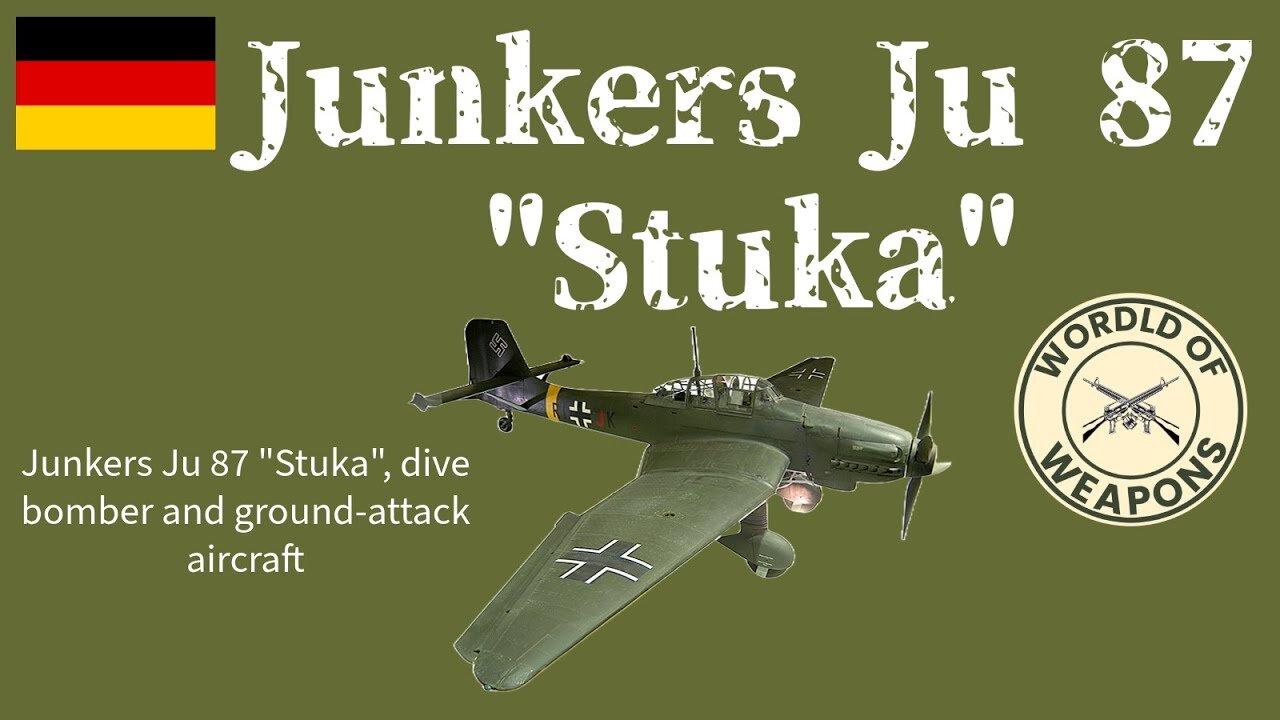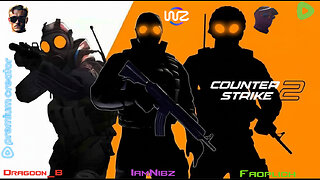Premium Only Content

Ju 87 "Stuka" 🇩🇪 The terror of Europe’s skies
Junkers Ju 87 "Stuka", dive bomber and ground-attack aircraft
1.Introduction 00:00
2.Wings 01:16
3.Weapon System 02:05
4.Engine 02:32
5.Diving procedure 03:45
6.Deployment 06:22
The Junkers Ju 87, popularly known as the "Stuka", from the German word for dive-bomber (Sturzkampfflugzueg), is a German dive bomber and ground-attack aircraft. Designed by Hermann Pohlmann, it first flew in 1935. The Ju 87 made its combat debut in 1937 with the Luftwaffe's Condor Legion during the Spanish Civil War between 1936 and 1939 and served the Axis in World War 2 from beginning to end.
The aircraft is easily recognizable by its inverted gull wings and fixed spatted undercarriage. Upon the leading edges of its faired main gear legs were mounted ram-air sirens known as Jericho trumpets, which became a propaganda symbol of German air power and of the so-called Blitzkrieg victories of between 1939 and 1942, as well as providing Stuka pilots with audible feedback as to speed. The Stuka's design included several innovations, including automatic pull-up dive brakes under both wings to ensure that the aircraft recovered from its attack dive even if the pilot blacked out from the high g-forces, or suffered from target fixation.
The wing was the most unusual feature. It consisted of a single central section and two outer sections installed using four universal joints. The center section had a large negative dihedral (anhedral) and the outer surfaces a positive dihedral.
The offensive armament was two 7.92 mm (.312 in) MG 17 machine guns fitted one in each wing outboard of undercarriage, operated by a mechanical pneumatics system from the pilot's control column. The rear gunner/radio operator operated one 7.92 mm (.312 in) MG 15 machine gun for defensive purposes.
The engine and propeller had automatic controls, and an auto-trimmer made the aircraft tail-heavy as the pilot rolled over into his dive, lining up red lines at 60°, 75° or 80° on the cockpit side window with the horizon and aiming at the target with the sight of the fixed gun. The heavy bomb was swung down clear of the propeller on crutches prior to release.
The Ju 87 operated with considerable success in close air support and anti-shipping roles at the outbreak of World War II. It led air assaults in the invasion of Poland in September 1939. Stukas proved critical to the rapid conquest of Norway, the Netherlands, Belgium, and France in 1940. Though sturdy, accurate, and very effective against ground targets, the Stuka was, like many other dive bombers of the period, vulnerable to fighter aircraft. During the Battle of Britain of 1940–1941, its lack of maneuverability, speed, or defensive armament meant that it required a heavy fighter escort to operate effectively.
Diving procedure:
Flying at 4,600 m (15,100 ft), the pilot located his target through a bombsight window in the cockpit floor. The pilot moved the dive lever to the rear, limiting the "throw" of the control column. The dive brakes were activated automatically, the pilot set the trim tabs, reduced his throttle and closed the coolant flaps. The aircraft then rolled 180°, automatically nosing the aircraft into a dive. Red tabs protruded from the upper surfaces of the wing as a visual indicator to the pilot that, in case of a g-force induced black-out, the automatic dive recovery system would be activated. The Stuka dived at a 60–90° angle, holding a constant speed of 500–600 km/h (310–370 mph) due to dive-brake deployment, which increased the accuracy of the Ju 87's aim.
When the aircraft was reasonably close to the target, a light on the contact altimeter (an altimeter equipped with an electrical contact which triggers at a preset altitude) came on to indicate the bomb-release point, usually at a minimum height of 450 m (1,480 ft). The pilot released the bomb and initiated the automatic pull-out mechanism by depressing a knob on the control column. An elongated U-shaped crutch located under the fuselage swung the bomb out of the way of the propeller, and the aircraft automatically began a 6g pullout. Once the nose was above the horizon, dive brakes were retracted, the throttle was opened, and the propeller was set to climb. The pilot regained control and resumed normal flight. The coolant flaps had to be reopened quickly to prevent overheating. The automatic pull-out was not liked by all pilots.
Physical stress on the crew was severe. Human beings subjected to more than 5g in a seated position will suffer vision impairment in the form of a grey veil known to Stuka pilots as "seeing stars". They lose vision while remaining conscious; after five seconds, they black out. The Ju 87 pilots experienced the visual impairments most during "pull-up" from a dive.
-
 3:20
3:20
World Of Weapons
1 year agoChiappa Rhino 🇮🇹 Italian strength, power and softness at the same time
102 -
 8:48
8:48
Faith Frontline
12 hours agoThe Moment That Shattered Dave Smith’s Atheist Beliefs
10K3 -
 2:39:17
2:39:17
Side Scrollers Podcast
17 hours agoKing of the Couch 2025: WHO WILL TAKE THE CROWN?!
60.4K3 -
 10:58
10:58
MattMorseTV
19 hours ago $4.99 earnedLindsey Graham just got EXPOSED.
22K65 -
 LIVE
LIVE
BEK TV
23 hours agoTrent Loos in the Morning 6/19/2025
320 watching -
 3:19
3:19
Rena Malik, M.D.
23 hours ago $1.63 earnedUrologist explains why you pee more often in the winter
16.3K8 -
 19:30
19:30
Ohio State Football and Recruiting at Buckeye Huddle
3 days agoOhio State Football: Which Playoff Format Would be the Best for the Buckeyes?
13.2K1 -
 36:25
36:25
Esports Awards
18 hours agoLaunders on CS2, Esports Evolution & Staying Real in the Game | Origins Podcast #12
24.5K2 -
 18:40
18:40
Lacey Mae ASMR
16 hours ago $0.59 earnedASMR Glue, Slime, and Shaving Cream on The Mic!
22K2 -
 8:15:16
8:15:16
IamNibz
9 hours ago $0.50 earnedA NEWBIE LEARNING CS2 With Dragoon_B And Faoplich!
16.7K